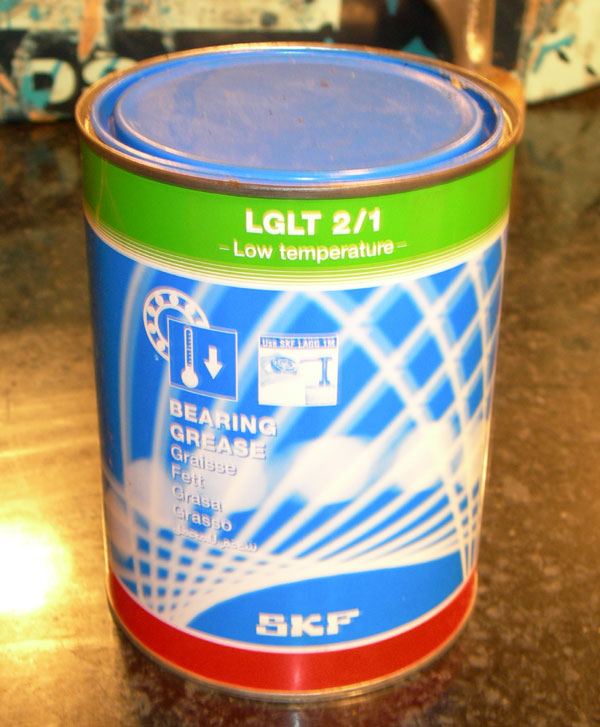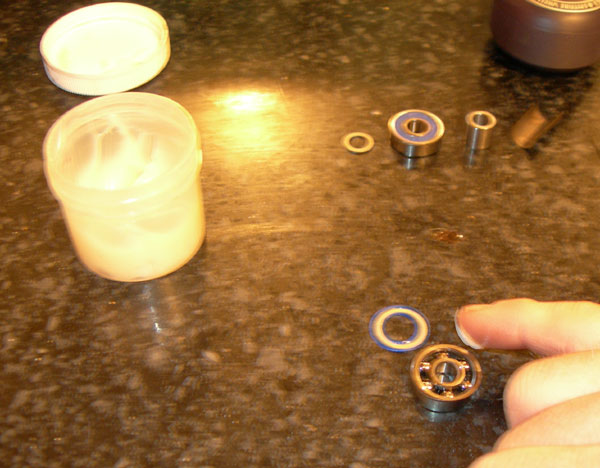Difference between revisions of "Lubricating Skate Bearings"
(→Lubrication tools) |
|||
| (25 intermediate revisions by the same user not shown) | |||
| Line 1: | Line 1: | ||
| − | + | Proper lubrication of skate bearings (like any bearing) is the key to long lasting, fast bearings. Many skate bearings are supplied with totally inadiquate lubrication for even a day of skating, let alone the expected life of the bearing. Cleaning and lubricating the bearing before use will help ensure maximum performance. | |
| − | The | + | ===Objective=== |
| + | The goal in lubricating a skate bearing is to surround the ball with a robust film of grease or oil to provide the contact at the races enough support to glide. | ||
| − | + | At the very least, the bearing must have at least on sheild on the outside to keep dirt out and lubrication in. A labyrinth neoprene seal on both sides is the best protection, but just getting a set of basic seals is difficult enough. | |
| − | + | A sealed and greased skate bearing is preferred to one that is oiled due to the fact that skateboarders simply do not clean and re-lube at intervals even close to necessary for oil use. Meticulous racers should run an oiled bearing, but only if they clean and re-lube throughout the day. A greased bearing is basically maintenance free, but can be cleaned and re-lubed if need be. | |
| + | ===Greases=== | ||
| + | The bearing cartridge is not to be packed full of grease, only enough to coat the actual balls (20% of open space). Too much grease causes unnecessary pumping friction. | ||
| − | + | SKF Grease LGLT 2, polyalphaolefin (PAO) synthetic base oils grease with a lithium soap thickener (NLGI Grade 1.5) is considered the standard bearing grease for general skate use. This is some expensive stuff. [http://www.maintenanceproductsdirect.com/Low_Temperature_High_Speed_Bearing_Grease_p/skf-lglt%202.htm Maintenance Products Direct] sells it for $70 per 1.0 kg. | |
| − | + | [[Image:Bearing3.jpg]] | |
| − | |||
| + | [http://www.pvdwiki.com/images/4/46/LGLT2_datasheet.pdf SKF LGLT2 Data Sheet] | ||
| + | |||
| + | ===Oils=== | ||
| + | If oiling bearings for max speed, exactly 2 drops of an ISO 13 oil should be applied. Basically you need a grease rated at MIL-G-23827. To understand some more details regarding grease specifications read THIS. | ||
| + | |||
| + | One of the most popular oils is [http://www.kpg-industrial.com/triflow/ Tri Flow] A Sherman-Williams product available in most bicycle dealers and hardware stores. | ||
| + | |||
| + | [http://www.pvdwiki.com/images/5/55/Tri-Flow_Industrial_Lubricant.pdf Tri-Flow Data Sheet] | ||
| + | |||
| + | ===Lubrication tools=== | ||
| + | |||
| + | About the best way to get grease or oil into a skate bearing is by using a syringe. I found some cheap suppliers online. Microtools has a good selection of [http://www.micro-tools.com/store/item_detail.aspx?ItemCode=CF10-10 syringes], at good prices, with a variety of [https://www.micro-tools.com/store/item_detail.aspx?ItemCode=KDS15-1 needles] to choose from (15 guage or larger works well). | ||
| − | [http://www. | + | [[Image:Bearing8.jpg]] |
| + | |||
| + | ===Products to avoid=== | ||
| + | [http://www.wd40.com/Brands/wd40.cfm WD-40] is one of the worst products to ever use for true lubrication. WD-40 is extremly similar to kerosene. Like kerosene, it does have some very weak lubricating properties but is mainly useful as a cleaning agent. | ||
| + | |||
| + | ===External Links=== | ||
| + | |||
| + | [http://www.ntnamerica.com/Engineering/PDFs/2200/lube.pdf NTN on Lubrication] | ||
| + | <br> | ||
| + | [http://www.skf.com/portal/skf/home/solutions;jsessionid=RZG500DKAOAE5QFID0MCFE15AAAACIV0?paf_dm=shared&paf_gear_id=600029&contentId=0.000336.000479.000962.001096.000372.001184&action=viewDetail&lang=en SKF on Lubrication and Cleaning]. | ||
| + | [http://www.minibearings.com.au/hobby/skate.html minibearings.com] | ||
[[Category:Skateboard]] | [[Category:Skateboard]] | ||
[[Category:Bearings]] | [[Category:Bearings]] | ||
Latest revision as of 21:34, 30 October 2006
Proper lubrication of skate bearings (like any bearing) is the key to long lasting, fast bearings. Many skate bearings are supplied with totally inadiquate lubrication for even a day of skating, let alone the expected life of the bearing. Cleaning and lubricating the bearing before use will help ensure maximum performance.
Objective
The goal in lubricating a skate bearing is to surround the ball with a robust film of grease or oil to provide the contact at the races enough support to glide.
At the very least, the bearing must have at least on sheild on the outside to keep dirt out and lubrication in. A labyrinth neoprene seal on both sides is the best protection, but just getting a set of basic seals is difficult enough.
A sealed and greased skate bearing is preferred to one that is oiled due to the fact that skateboarders simply do not clean and re-lube at intervals even close to necessary for oil use. Meticulous racers should run an oiled bearing, but only if they clean and re-lube throughout the day. A greased bearing is basically maintenance free, but can be cleaned and re-lubed if need be.
Greases
The bearing cartridge is not to be packed full of grease, only enough to coat the actual balls (20% of open space). Too much grease causes unnecessary pumping friction.
SKF Grease LGLT 2, polyalphaolefin (PAO) synthetic base oils grease with a lithium soap thickener (NLGI Grade 1.5) is considered the standard bearing grease for general skate use. This is some expensive stuff. Maintenance Products Direct sells it for $70 per 1.0 kg.
Oils
If oiling bearings for max speed, exactly 2 drops of an ISO 13 oil should be applied. Basically you need a grease rated at MIL-G-23827. To understand some more details regarding grease specifications read THIS.
One of the most popular oils is Tri Flow A Sherman-Williams product available in most bicycle dealers and hardware stores.
Lubrication tools
About the best way to get grease or oil into a skate bearing is by using a syringe. I found some cheap suppliers online. Microtools has a good selection of syringes, at good prices, with a variety of needles to choose from (15 guage or larger works well).
Products to avoid
WD-40 is one of the worst products to ever use for true lubrication. WD-40 is extremly similar to kerosene. Like kerosene, it does have some very weak lubricating properties but is mainly useful as a cleaning agent.

